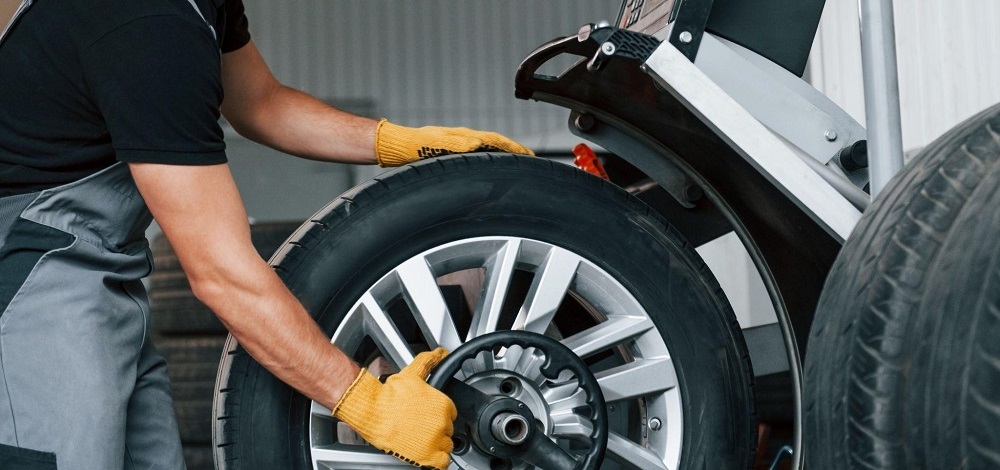Obtain Road-Ready with Expert GMC Tires Service at Morris Tires
Obtain Road-Ready with Expert GMC Tires Service at Morris Tires
Blog Article
Tire Service: The Impact of Weather Problems
When it comes to guaranteeing optimum performance and security on the roadway, comprehending the effect of climate conditions on tire solution is crucial. GMC Tire Service. In this discussion, we will discover the intricate partnership between weather problems and tire service, dropping light on the relevance of weather-specific tire maintenance methods and considerations.
Warmth and Tire Efficiency
When revealed to heats, tires experience adjustments in performance that can considerably influence car safety and security and handling. The heat produced from prolonged driving or hot weather condition conditions causes the tire rubber to soften, leading to minimized walk life and raised wear. As the rubber ends up being softer, the tire's grasp when traveling lessens, affecting stopping ranges and total grip. In severe situations, too much warm can even trigger tire blowouts, posturing an extreme safety threat to the car and its passengers.

Winter Results
Cold climate conditions can have a considerable effect on tire performance and security. As temperature levels decline, tire rubber can solidify, resulting in reduced grip on icy or snow-covered roads. In winter, tires may likewise shed air stress more rapidly, which can impact handling and fuel performance. Additionally, cold temperature levels can trigger tire sidewalls to stiffen, enhancing the threat of damages from splits or various other roadway dangers.
To minimize the impacts of winter on tires, it is essential to on a regular basis examine tire pressure and inflate them to the producer's suggested degrees. Making use of wintertime or all-season tires made for chilly weather condition problems can additionally boost traction and hold on icy or snowy roadways. Correct tire maintenance, including regular evaluations for wear and damages, comes to be also much more important during chillier months to guarantee ideal efficiency and safety.
Rainy Conditions Effect
Throughout rainy problems, tire efficiency and safety can be substantially influenced by the damp roadway surface areas and decreased visibility. The tread pattern of tires plays a crucial function in preserving grip on damp roads. Tires with worn-out treads are much more prone to hydroplaning, where a layer of water builds up between the roadway and the tire surface, leading to loss of grip. To battle this, vehicle drivers need to frequently check their tires for appropriate tread depth and consider spending in tires especially made for wet conditions.
Additionally, rainy climate can additionally lower exposure, making it testing for motorists to see the road in advance clearly (GMC Tire Service). In such problems, here are the findings it is important to change driving rates appropriately and maintain a risk-free complying with distance to permit abrupt stops. Correctly inflated tires can also aid in keeping control on damp roads by giving better handling and grasp
Snow and Tire Security
When driving in snowy conditions, having the best tires can make a considerable distinction in safety and security and performance. Winter season tires are made with unique rubber substances and walk patterns to supply better traction on snow and ice contrasted to all-season tires.

It is vital to adhere to maker guidelines when using and installing tire chains to avoid damages to the tires and car. By choosing the appropriate tires, keeping correct rising cost of living, and thinking about added traction aids like tire chains, drivers can boost their safety when browsing snow-covered roads.
Weather-Related Tire Maintenance
Weather-related tire maintenance encompasses an array of techniques intended at guaranteeing optimal tire feature and durability in different climate circumstances. One key facet of weather-related tire maintenance is tire stress guideline. Checking tire tread frequently and changing tires when tread wear reaches a particular deepness these details is crucial for maintaining grip and security in unfavorable weather.
Verdict
In final thought, climate condition have a substantial influence on tire efficiency and safety. From warm influencing tire pressure and wear to winter minimizing traction, it is vital to consider the climate when maintaining and making use of tires. Stormy problems can reduce grasp and cause hydroplaning, while snow can enhance the danger of accidents if tires are not correctly outfitted. Weather-related tire maintenance is important in making certain optimum performance and safety and security on the roadways.
In this conversation, we will certainly discover the detailed relationship between climate problems and tire solution, shedding light on the significance of weather-specific tire maintenance practices this website and considerations.

Report this page